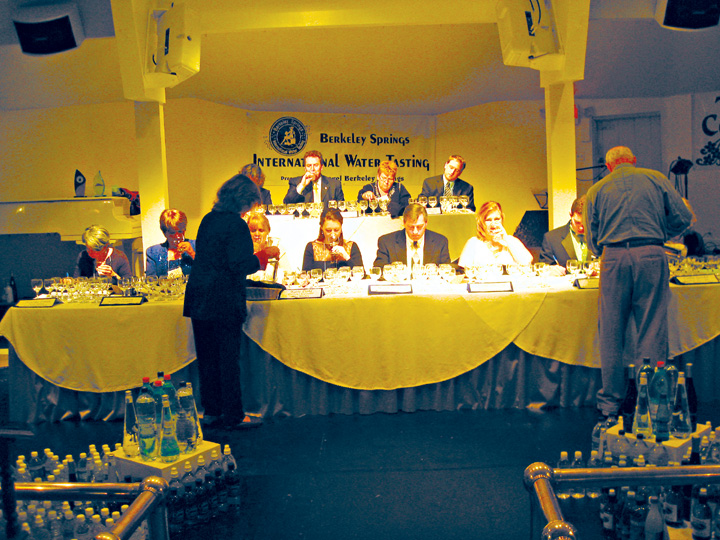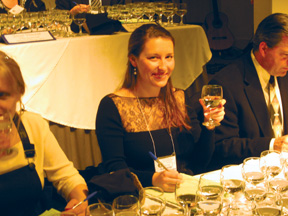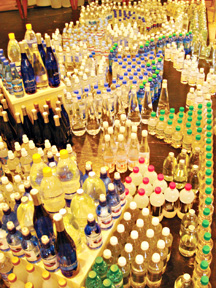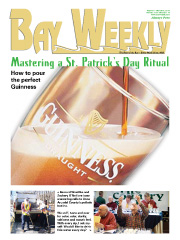A Test of Taste
How we measure up to the Olympians of water


 story and photos by Katie Dodd
story and photos by Katie Dodd
Twenty-one glasses range before me in neat rows on a long, narrow table.
When I’ve worked through the first round, a second set of nine glasses follows. Then 14 more. Finally another 20. There are no spittoons in sight.
On other Saturday nights, I might have stumbled out the door. On this occasion, I felt healthy, clear-headed and refreshed. This Saturday, I was drinking water, judging the 20th Berkeley Springs International Water Tasting Competition.
“Take three short sniffs with your nose right in the glass,” Arthur van Wiesenberger, master of ceremonies at the annual Olympics of water tasting, directs the panel of judges. “Then take a sip. Roll it over your mouth; cover the whole palate. Think of the flavors circulating in your mouth. Focus on what you like.”
Glass after glass, we sniff, taste and peer for color, odor, clarity, saltiness and mouth feel. With every sip, I asked myself one question: Would I like to drink this water every day?
Developing a Taste
The Berkeley Springs International Water Tasting Competition is the largest and longest running competition of its kind. Each winter, the West Virginia spa-town bustles with the activity of judges, contestants and spectators who have traveled from all over the world to be a part of the novel event. This year it drew in 88 waters — more than ever before — and included entries from New Zealand, China, Japan, Bosnia, Macedonia, British Columbia and dozens from the United States. Contenders hoped to secure a medal — and with it, bragging rights — for the best in one of several categories: municipal water, sparkling water, non-carbonated bottled water and purified drinking water.
Water Master van Wiesenberger makes the trip each year from Santa Barbara, California, to preside over the event. Before the official evaluating, he tutors judges on what makes a contestant’s water the best of its kind. Water should generally be clear, have no aroma and feel pleasant in the mouth. After swallowing, no heavy residue or trace of staleness should linger.
I was not the only judge new to water tasting, but I was likely the least experienced in official tastings, for I was a complete novice. I paid close attention to Wiesenberger’s tutorial, wondering if my palate would be able to taste any difference between the waters.
The test run was a challenge. There were only three waters to evaluate, but as I sipped each one, I wondered if the tiny variations I perceived were actually my imagination searching desperately for something distinguishable. I passed the trial by agreeing that no, the three waters were not all the same. Then the real judging began. A curious audience looked on, barely visible beyond bright yellow lights illuminating our work.

As the dozens of waters were poured and sipped, I found it easier to sense the differences. Some were sweet, others slightly pungent and a couple were actually unpleasant on the tongue. But for the most part, they were just as they should be: completely tasteless.
The 12 judges chosen to be water tasters are always journalists. The idea is that these writers, broadcasters and bloggers will spread the word about their experience — and about Berkeley Springs. Until a couple of months ago, I had never heard of the competition or of water tasting in general. But when a friend (and former judge) recommended I apply, I decided not to let my ignorance deter a unique venture. And possibly my only chance of being addressed as Your Honor.
The Best of the Taps
In the municipal, or tap water category, Hamilton, Ohio, took home the gold medal. The city’s water came in first over two other municipal waters from British Columbia — just the opposite results of the final Olympic hockey battle ensuing at the same time that evening between the United States and our northern neighbor.
“We’re all very excited here,” said Greg Petredis, Hamilton’s water production superintendent. “It’s quite an honor. We always knew we had excellent water. This just proves it.”
The tap water in Hamilton is groundwater sourced from the Great Miami Buried Aquifer. It is pumped from 100 feet underground and through a conventional softening method that adds lime to reduce the hardness of the water. In addition, the water undergoes aeration, flocculation and filtration to remove solid particles. Fluoride is added to strengthen teeth.
“What distinguishes us from most other communities in our water treatment is the disinfection process,” said Petredis. “We use chlorine dioxide. Most other plants use chlorine alone, which can have the odor of swimming pools. With the chlorine dioxide, you don’t experience that.”
In other words, a lot of work goes into producing tasteless clarity.
From Tap to Table
Back home from the judging, I wondered how my home waters compared. Public water in Anne Arundel and Calvert counties and municipalities, I found, is prepared not so differently from water in Hamilton, Ohio. Our waters don’t taste much different, either. But taste, I learned, isn’t the only issue of concern to the people who bring us our public drinking water.
The Calvert town of Chesapeake Beach, population 3,600, pumps groundwater from the Aquia Aquifer, adding chlorine, phosphate and polyphosphate to disinfect the water and hide the taste of iron, before storing the water in one of the town’s two water towers. A third now being built will hold an additional 350,000 gallons.
“If you’re drinking our water, you don’t have to worry about having any contaminants in it,” says Wilson Cochran, Public Works superintendent for Chesapeake Beach. “You can filter it if you’re worried, but it’s not necessary.”
America’s municipal water systems were created for fire protection. Today, they also provide drinking water for cities and towns. The water starts out raw, as either surface or groundwater. In Chesapeake Country, it is more often groundwater, which is pumped up from aquifers to treatment plants. There, the water passes through several processes: aeration, coagulation, flocculation, sedimentation and filtration. Solid particles are removed, chlorine is added as a disinfectant and fluoride is added. The water is then distributed through water mains straight to the taps of homes and businesses.
In North Beach, two wells draw water from the Aquia Aquifer, the same source drawn on by Chesapeake Beach. The aquifer, which supplies water to many people in this region, is surrounded by heavy clays, preventing surface water from trickling down and mixing with its holdings.
“We have good water,” says John Hofman, town engineer in North Beach. “Some systems in other parts of Maryland have greater issues with iron; we’re fortunate that our water doesn’t require any additional treatment.”
Anne Arundel County also places water high on its list of priorities, spending an average of $50 million a year to improve the system that pumps water from three aquifers to 100,000 homes and businesses. At any given time, there are more than 25 ongoing projects to improve the water system.
“Meeting and exceeding water control standards is not just a goal, it’s a must,” said Matt Diehl, a spokesman for the Anne Arundel County Department of Public Works, reiterating the words of County Executive John R. Leopold.
Both Anne Arundel and Calvert counties and municipalities take water safety seriously and work not only to adhere to county, state and federal guidelines for citizens’ health and wellbeing, but also to ensure that the water can always meet the demand.
“Regulations require that we are able to meet the highest demand, which is usually in July or August, even if the largest well is out of commission,” says Annapolis’ Water Plant Superintendent James Fitzgerald. “And we are, pumping about four million gallons every day for the 35,000 city residents.”
Annapolis city water, which is pumped from three aquifers using six wells, competed in Berkeley Springs’ Water Tasting Competition in 1992, tying for second place in the municipal category.
“I know we produce good water,” says Fitzgerald. “We haven’t had any kind of violation in the 15 years I’ve been here. There are lots of regulations, so that’s a pretty good record.”

 With Every Sip
With Every Sip
Since my judging in Berkeley Springs, I have looked at water in not quite the same way — and I don’t think I ever will. With every sip, I assess: How do I rate this one? I find myself wondering where the water I drink has been, whether from a home well through the mini-chemistry laboratory in my garage or the miles of water main from an aquifer hundreds of feet beneath me.
I’d like to say that with my newly gained knowledge of water I have a higher standard for what I drink. But in all honesty, the water from my refrigerator’s dispenser tastes just fine. I’m perfectly happy drinking this water every day.
Still, I won’t object if you call me Your Honor.
![]()





